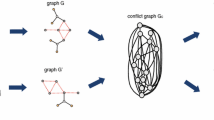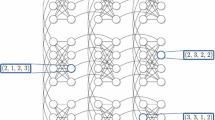Abstract
Quantum annealers have been designed to propose near-optimal solutions to NP-hard optimization problems. However, the accuracy of current annealers such as the ones of D-Wave Systems, Inc., is limited by environmental noise and hardware biases. One way to deal with these imperfections and to improve the quality of the annealing results is to apply a variety of pre-processing techniques such as spin reversal (SR), anneal offsets (AO), or chain weights (CW). Maximizing the effectiveness of these techniques involves performing optimizations over a large number of parameters, which would be too costly if needed to be done for each new problem instance. In this work, we show that the aforementioned parameter optimization can be done for an entire class of problems, given each instance uses a previously chosen fixed embedding. Specifically, in the training phase, we fix an embedding E of a complete graph onto the hardware of the annealer, and then run an optimization algorithm to tune the following set of parameter values: the set of bits to be flipped for SR, the specific qubit offsets for AO, and the distribution of chain weights, optimized over a set of training graphs randomly chosen from that class, where the graphs are embedded onto the hardware using E. In the testing phase, we estimate how well the parameters computed during the training phase work on a random selection of other graphs from that class. We investigate graph instances of varying densities for the Maximum Clique, Maximum Cut, and Graph Partitioning problems. Our results indicate that, compared to their default behavior, substantial improvements of the annealing results can be achieved by using the optimized parameters for SR, AO, and CW.
Access this chapter
Tax calculation will be finalised at checkout
Purchases are for personal use only
Similar content being viewed by others
References
Andriyash, E., Bian, Z., Chudak, F.A., King, A.D., Macready, W.G.: Boosting integer factoring performance via quantum annealing offsets. Technical report, D-Wave Systems (2016)
Chapuis, G., Djidjev, H., Hahn, G., Rizk, G.: Finding maximum cliques on the D-wave quantum annealer. J. Signal Process. Syst. 91(3–4), 363–377 (2019)
D-Wave Systems: Quantum Computing for the Real World Today (2000)
D-Wave Systems: Graph Partitioning QUBO (2019). https://github.com/dwave-examples/graph-partitioning/blob/master/graph_partitioning.py
D-Wave Systems: Maximum Cut QUBO (2019). https://github.com/dwave-examples/maximum-cut/blob/master/maximum_cut.py
D-Wave Systems: D-Wave System Documentation: Solving a Problem on the QPU - Using Spin-Reversal (Gauge) Transforms. Technical report, D-Wave Systems (2020)
D-Wave Systems: Technical Description of the D-Wave Quantum Processing Unit (2020)
King, A.D., Hoskinson, E., Lanting, T., Andriyash, E., Amin, M.H.: Degeneracy, degree, and heavy tails in quantum annealing. Phys. Rev. A 93(5), 052320-1–052320-12 (2016)
Pelofske, E., Hahn, G., Djidjev, H.: Optimizing the spin reversal transform on the D-wave 2000Q. In: Proceedings of the 2019 IEEE International Conference on Rebooting Computing (ICRC), pp. 1–8 (2019)
Pelofske, E., Hahn, G., Djidjev, H.: Inferring the Dynamics of Ground-State Evolution of Quantum Annealers arXiv:2009.06387, pp. 1–21 (2020)
Pelofske, E., Hahn, G., Djidjev, H.: Solving large maximum clique problems on a quantum annealer. In: Feld, S., Linnhoff-Popien, C. (eds.) QTOP 2019. LNCS, vol. 11413, pp. 123–135. Springer, Cham (2019). https://doi.org/10.1007/978-3-030-14082-3_11
Pudenz, K.L.: Parameter setting for quantum annealers. In: 2016 IEEE High Performance Extreme Computing Conference (HPEC), pp. 1–6 (2016)
Storn, R., Price, K.: Differential evolution - a simple and efficient heuristic for global optimization over continuous spaces. J. Global Optim. 11, 341–359 (1997)
Virtanen, P., et al.: SciPy 1.0 contributors: SciPy 1.0: fundamental algorithms for scientific computing in Python. Nat. Meth. 17, 261–272 (2020)
Acknowledgments
This work has been supported by the US Department of Energy through the Los Alamos National Laboratory. Los Alamos National Laboratory is operated by Triad National Security, LLC, for the National Nuclear Security Administration of U.S. Department of Energy (Contract No. 89233218CNA000001) and by the Laboratory Directed Research and Development program of Los Alamos National Laboratory under project numbers 20190065DR and 20180267ER.
Author information
Authors and Affiliations
Corresponding author
Editor information
Editors and Affiliations
Rights and permissions
Copyright information
© 2021 Springer Nature Singapore Pte Ltd.
About this paper
Cite this paper
Barbosa, A., Pelofske, E., Hahn, G., Djidjev, H.N. (2021). Optimizing Embedding-Related Quantum Annealing Parameters for Reducing Hardware Bias. In: Ning, L., Chau, V., Lau, F. (eds) Parallel Architectures, Algorithms and Programming. PAAP 2020. Communications in Computer and Information Science, vol 1362. Springer, Singapore. https://doi.org/10.1007/978-981-16-0010-4_15
Download citation
DOI: https://doi.org/10.1007/978-981-16-0010-4_15
Published:
Publisher Name: Springer, Singapore
Print ISBN: 978-981-16-0009-8
Online ISBN: 978-981-16-0010-4
eBook Packages: Computer ScienceComputer Science (R0)




